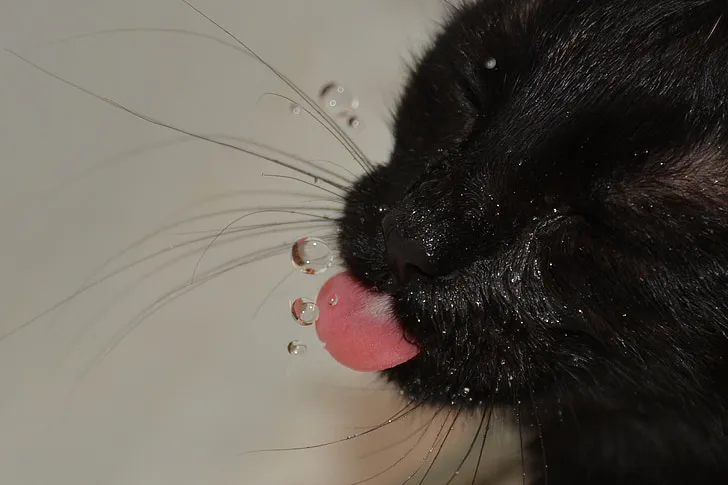Can Cats Share Our Drinks? A Guide for Cat Owners

As the temperature rises and refreshing beverages become a staple of our daily lives, cat owners might wonder: Can our feline friends partake in these cooling drinks? The short answer is, unfortunately, no. Most human beverages are unsuitable for cats, and some can even be toxic. Let's explore why certain drinks are off-limits for our furry companions.
Chocolate Drinks: A Serious Threat
Chocolate is highly toxic to cats due to the presence of theobromine (a methylxanthine). Here's what you need to know:
- 20mg/kg can cause vomiting and diarrhea
- 40-50mg/kg may lead to cardiac toxicity
- Over 60mg/kg can result in seizures and be life-threatening
While a tiny lick might not be fatal, it's crucial to keep all chocolate products away from cats. Chocolate drinks, in particular, often contain concentrated cocoa powder and cocoa butter, making them even more dangerous.
Alcoholic Beverages: Strictly Prohibited
Alcohol is extremely dangerous to cats. Cats are much more prone to alcohol poisoning than humans and even small amounts can lead to vomiting, diarrhea, disorientation, and in severe cases, death.
Never offer alchoholic drinks to your cats and keep them far away from your feline friends! If you suspect your cat has ingested alcohol, contact your veterinarian immediately.
Coffee: Another Methylxanthine Menace
Coffee contains caffeine, another methylxanthine that's toxic to cats. While most cats don't enjoy black coffee, they might be tempted by sweetened or milk-based coffee drinks. Caffeine ingestion may affect the digestive, nervous and cardiovascular systems in cats. Even a small amount can be fatal if left untreated, so it's best to keep all coffee products out of reach of cats.

Tea: Stimulating but Dangerous
Tea leaves contain theine and caffeine, both of which are toxic to cats. Ingestion can lead to digestive issues and overstimulate their central nervous system. Although less toxic than chocolate or coffee, tea should still be avoided.
Fruit Juices: A Mixed Bag
The safety of fruit juices depends on the fruit:
- Juices from toxic fruits like grapes and citrus are absolutely forbidden.
- Juices from cat-safe fruits (e.g., apples, pears, watermelon, strawberries) aren't toxic but offer little nutritional value and may cause digestive upset.
While an occasional sip of cat-safe fruit juice won't harm your pet, it's not recommended as part of their regular diet.
Carbonated Drinks: Intriguing but Uncomfortable Bubbles
You might have caught your cat eyeing your sparkling water with curiosity, seemingly eager to take a sip. While plain carbonated water isn't toxic to cats, it's not the best choice for their hydration needs. In fact, those enticing bubbles can lead to some uncomfortable side effects.
Pure carbonated water without any additives (like artificial sweeteners) won't poison your feline friend. Some cats might even find the bubbles intriguing, potentially encouraging them to drink more. However, there's a downside: the carbonation can cause gas to build up in your cat's stomach. This can result in bloating, discomfort, and digestive issues.
What Can Cats Drink?
If you want to offer your cat a special drink, consider:
- Catnip-infused water: A fun treat that is safe for cats.
- Cat grass juice: This can be a refreshing option that provides some enrichment.
- Lactose-free milk (without additives): Some cats enjoy this as a treat, but it should not replace water.
These options are safe and can provide some enrichment for your cat.

The Best Drink for Cats and Suggestions
Ultimately, the best and safest drink for cats is plain, fresh water. Ensure your cat always has access to clean water, especially during hot summer months.
If your cat seems reluctant to drink water, there are several ways to make hydration more appealing:
- Invest in a cat water fountain: Many cats are instinctively drawn to moving water. A cat fountain creates a constant flow that can pique your feline's interest and encourage more frequent drinking.
- Try a pet water pump: These devices create a gentle stream of water in your cat's regular bowl, simulating a natural water source.
- Experiment with different bowl materials: Some cats prefer ceramic or stainless steel bowls over plastic ones, which can retain odors.
- Place multiple water stations: Distribute water bowls throughout your home to increase accessibility and reminder your cat to drink.
- Flavor the water slightly: You can add a small amount of low-sodium chicken broth or tuna juice to make the water more enticing. Just be sure to change it frequently to prevent bacterial growth.
- Keep the water fresh: Change your cat's water daily and clean the bowl regularly to ensure it's always fresh and appealing.
Remember, when it comes to your cat's health, it's always better to err on the side of caution. If you suspect your cat has ingested any harmful substances, contact your veterinarian immediately.